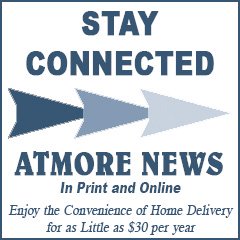By DON FLETCHER
News Staff Writer
As Atmore Community Hospital officials prepare for the future, they are working in the present to bring specialized care to local and area residents who in the past would have been immediately transferred to another facility.
ACH Administrator Brad Lowery told local media during a Monday, June 27, press event that the local medical facility expects to begin next week the third phase of a four-phase telemedicine partnership that allows ACH patients to be examined by University of Alabama Birmingham specialists without having to leave the local hospital.
Atmore Community Hospital staff currently work with UAB specialists, who are online within 10 minutes of notification, on critical care cases and stroke-related or other neurological emergencies. If all goes as planned, that will expand by early July to include nephrology.
The ACH administrator furnished statistics that show the current telemedicine hookup is working.
“We started with Tele-Stroke back in January,” Lowery said during the meeting, which was also attended by Director of Nursing Suzanne McGill and Jason Daniel, director of public affairs and marketing for Escambia County Healthcare Authority (ECHCA). “So far, we’ve had about 20 Tele-Stroke cases, and seven patients were able to stay (at ACH). We’ve had six critical care incidents, and three of those could have stayed here if we had a pulmonologist.”
Hospital officials also provided further proof of the program’s success, especially with patients who are displaying stroke symptoms.
Local businessman Rob Faircloth, who recently arrived at ACH with such symptoms, allowed public disclosure of his experience and offered his assessment of the telemedicine program.
Faircloth reportedly had some “mental confusion and what he thought were stroke symptoms” at home recently. He was taken to ACH’s emergency department, where he was quickly evaluated by a UAB doctor and treated for a possible stroke.
“My wife brought me up to the hospital, we came right in, and within only a few minutes the neurological specialist physician with UAB came on the screen via teleconference,” the local business and civic leader said. “We had a good back-and-forth dialogue, and he asked me all the questions he needed to ask and asked the ER doctor what he had observed in his evaluation. I felt really comfortable about the process.”
Lowery pointed out that without the telemedicine partnership, Faircloth most likely would have been stabilized and immediately transferred to a larger hospital. Faircloth agreed.
“Normally, you would expect to get shipped somewhere, but that wasn’t the case,” he said. “If I get shipped out, it’s like I have to start back in line at the next hospital and start all over.”
He added that the experience was made even less stressful by the comfort of being able to stay near his family and the confidence he has in the people who would be providing his treatment.
“We are from Atmore, and I’m comfortable with the nurses and doctors (at ACH), and ACH is the closest place to go for your healthcare,” he said. “I’ve never had a bad experience at ACH.”
ECHCA CEO Jeff Booth said local healthcare officials are continuing their quest to improve the quality of care offered at the local medical center, allowing more patients to remain closer to home for specialized care.
“Our goal is that more of our patients and fellow citizens will be able to stay at home for their care following their ER visit,” said Booth, who added: “We are working on additional services that we will hopefully be able to announce very soon.”
Lowery also revealed during Monday’s session that construction of ECHCA’s new primary care facility, located across Alabama 21 from Wind Creek, is continuing at a steady pace. Plans are to start accepting patients by August 29, he said.
